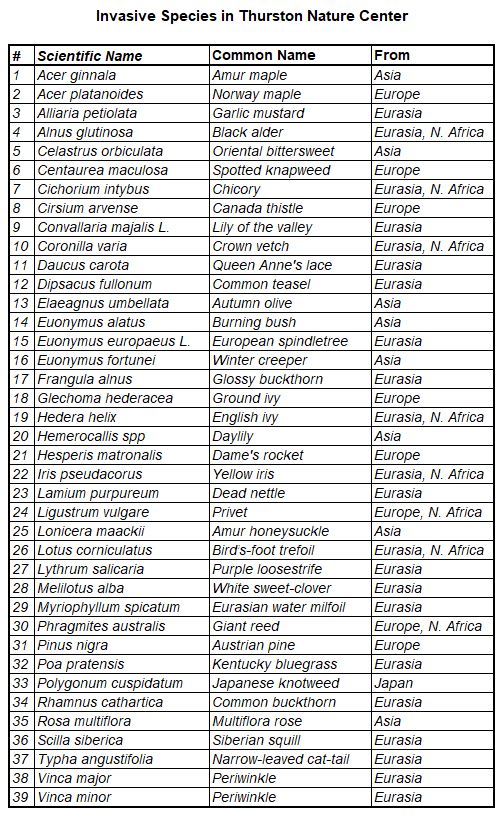Then there’s the stuff we DON’T want …
There are about 40 invasive plant species in Thurston Nature Center. We have been working for years to control many of these — some are a never-ending battle, others we have under pretty good control.
Invasive Plants
These are the non-native plants that are in Thurston Nature Center. Some of these are firmly entrenched throughout. Others are rare, either because: (a) they have only recently entered the Nature Center, (b) they are not highly invasive (just non-native); or (c) we have had good success controlling them.

Please Help
As you are adding plants to your own yard, please do NOT put any left-overs into the Nature Center! This has happened in the past, and it causes grief for TNC volunteers, who have been battling invasives for years. Ground covers – including ivy, vinca, pachysandra, winter creeper (Euonymus fortunei ) and deadnettle – are especially aggressive and difficult to remove. They, and plants spread by seeds and berries, can easily escape from nearby yards, something to consider if you live near any natural area.
TNC has a “natives only” and “approval required” policy for the introduction of plants (click here to see the policy for details and rationale).
Briefly, our policy is to use locally-native plants to provide the greatest benefit to wildlife (starting with butterfly and moth caterpillars – food for the babies of 90% of terrestrial bird species – which can only eat the leaves of a small number of native plant species). Monarchs and milkweed is the most well-known example, but there are hundreds of other required caterpillar-native plant pairings.
When deciding where to put new native plants, our stewards – Jim Vallem and Michael Tucker – take into account the needs of each plant, their size, current inventory of the plant, how they will fare with existing plants, and whether or not an area is ready for planting (i.e., cleared of invasives). If you have any extra native plants or seeds you think would be good additions to Thurston Nature Center, please see Jim or Tuck to develop a plan for their use. We appreciate our friends’ and neighbors’ help in keeping TNC useful to wildlife, and to its educational mission.
Control
One method to reduce the number of non-native invasives is with controlled ecological burns. Many invasives are sensitive to fire. For example, young buckthorn will be killed, while larger ones will be top-killed, preventing seed formation and requiring the plant to use up extra energy from the roots to begin regrowing. On the other hand, most native grasses and flowers, with their typically much deeper roots, actually benefit from occasional burns. Oaks and hickories are native trees that are very dependent on fire for their regeneration. Here is some background on why and how we do burns in TNC (PDF).
